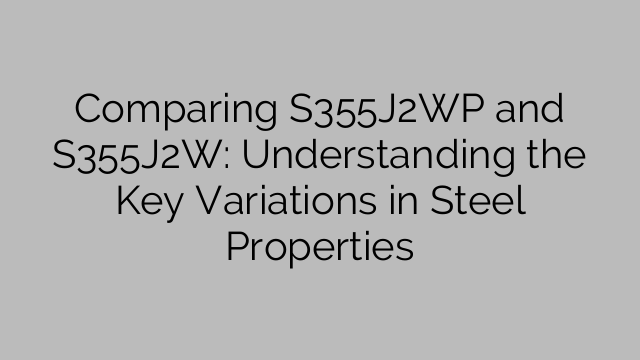When it comes to choosing the right steel for various applications, it is crucial to have a comprehensive understanding of different types of steel and their properties. In this article, we will compare two popular types of weather-resistant structural steels: S355J2WP and S355J2W. While both steels are designed to withstand harsh weather conditions, there are key differences in their properties that make them suitable for specific applications.
S355J2WP and S355J2W are both members of the S355 series of steel grades, which are widely used in construction and engineering due to their excellent strength and durability. These steels belong to the EN 10025 European standard, which specifies the technical delivery conditions for structural steels.
First, let’s understand the similarities between S355J2WP and S355J2W. Both steels are known for their corrosion resistance, making them ideal for outdoor structures such as bridges, buildings, and railway vehicles. They are designed to endure the effects of harsh weather conditions, including rain, snow, and humidity, without compromising on strength.
The key difference between S355J2WP and S355J2W lies in their chemical compositions. S355J2WP contains additional alloying elements such as copper, chromium, and phosphorus, which enhances its corrosion resistance. These alloying elements form a protective layer on the steel’s surface, preventing the penetration of moisture and oxygen, thereby reducing the risk of corrosion.
On the other hand, S355J2W lacks the additional alloying elements present in S355J2WP. This does not make it inferior to S355J2WP; rather, it signifies that S355J2W is better suited for applications where the atmosphere is less corrosive. This could include applications in urban environments or areas with lower exposure to aggressive substances. S355J2W is still considered highly corrosion-resistant but may require additional protective coatings in more aggressive environments.
Another key variation between S355J2WP and S355J2W is their impact properties. S355J2WP has a higher minimum impact energy value, typically measured at -20 degrees Celsius, compared to S355J2W. This means that S355J2WP can withstand higher impact forces without fracturing, making it suitable for applications exposed to extreme loading conditions.
It is important to note that both steels have good weldability, enabling them to be easily joined to other structural components during fabrication. This further enhances their versatility and makes them ideal for complex construction projects.
In summary, while S355J2WP and S355J2W are both weather-resistant structural steels, there are key variations in their properties. S355J2WP, with its additional alloying elements, possesses enhanced corrosion resistance, particularly in aggressive environments. It also has superior impact properties, making it suitable for applications subjected to extreme loading conditions. Meanwhile, S355J2W, while lacking the additional alloying elements, still offers excellent corrosion resistance and is better suited for applications in less aggressive environments.
Ultimately, the choice between S355J2WP and S355J2W depends on the specific requirements of the application and the level of corrosive exposure it will endure. Consulting with steel suppliers and experts can help determine the most suitable steel grade for your needs, ensuring the longevity and durability of your structures.

